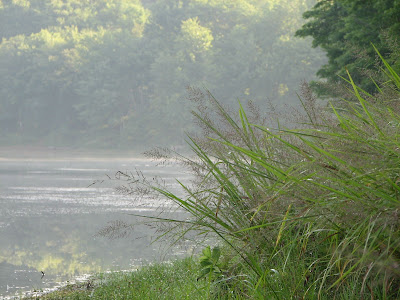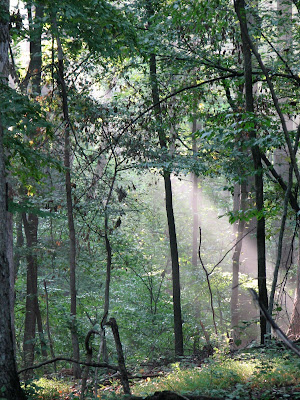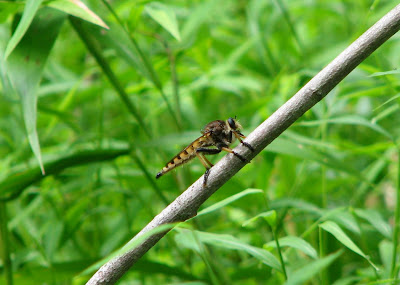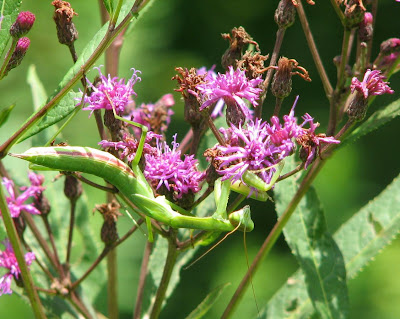As you may have heard, it’s been really, really hot and humid in much of the US lately, including my neck of the woods. I am not a fan of extremely hot weather, having grown up in Massachusetts. On one of the cooler days though, when temps peaked only (!) in the mid 90s, I managed to eke out a few hours of nature exploration. It was already hot and humid when I got outside in the morning, but worse was forecast for later in the week.
I wanted to check out Meadowside Nature Center, at the opposite end of Rock Creek Regional Park from Lake Frank. Unfortunately, I chose the one day the center is closed weekly. The trails are open sunrise to sunset, though, and there is also a small pond nearby. The pond was my primary target this trip anyway.
 |
| Meadowside's pond looks quiet but it's full of wildlife even in the heat. |
I found a ton of juvenile robins in the area, a few weeks or so past fledge. I love to watch adolescent birds, they’re so gawky and cute. I saw some of the robins in grassy areas near the nature center and many more in the forest later, bathing in and drinking from a small stream. Many of them were gaping too, the bird equivalent of panting. They didn’t like the heat any more than I did.
 |
| A few of the bathing robins trying to stay cool. |
When I got down to the pond I spotted a White-tail doe hock deep in the water, munching on juicy water lily and spatterdock leaves. She kept glancing up at me to see if I was a threat. But since I stayed still and crept closer only when her head was lowered, I got to watch her for several minutes before she trotted calmly away.
 |
| The spatterdock this doe is eating must be cool and tasty! |
The pond is small, but I spent almost the whole morning there. My husband gave me a copy of Dragonflies Through Binoculars this summer (thanks sweetie!), and there were tons of dragonflies around the pond. Although the guide is thorough, it’s not well set up for field use by a complete newbie. I would spot a dragonfly with a slate blue body and mostly unmarked wings, for example, and have to page through the entire set of color plates before I could find the ID. I wish it was somehow indexed or cross-referenced by key field marks instead of merely grouped by family classification. I’ll get the hang of it eventually though.
Anyway, my favorite dragonfly sighting was the dramatically marked Banded Pennant. I also found Eastern Pondhawks, Widow Skimmers, Amberwings, and Blue Dashers, plus others I couldn't identify.
 |
| I chased several Banded Pennants before I finally got one to hold still for a photo. |
 |
| I don't know what species this is, but it sure let me get close! Very cool. |
The most interesting dragonfly behavior I spotted was how a Blue Dasher dealt with the heat. Instead of perching broadside to the sun all the time, it did something called obelisking. It lifted its body into somewhat of a handstand, pointing the tip of its abdomen directly toward the sun to reduce its exposure. Definitely something I could identify with!
 |
| Blue Dasher perched normally |
 |
| A few minutes later... Blue Dasher obelisking to stay cool. |
After the pond I spent a short while on the shady, wooded trails, but even there I couldn’t escape the sweltering heat. Eventually I just had to give in. I headed home around noon, a couple hours earlier than I normally do. I’ll return again soon, though, once the weather is a little more tolerable for this New England girl!
This entry’s location:
Meadowside Nature Center, Rock Creek Regional Park, Rockville, MD.























































